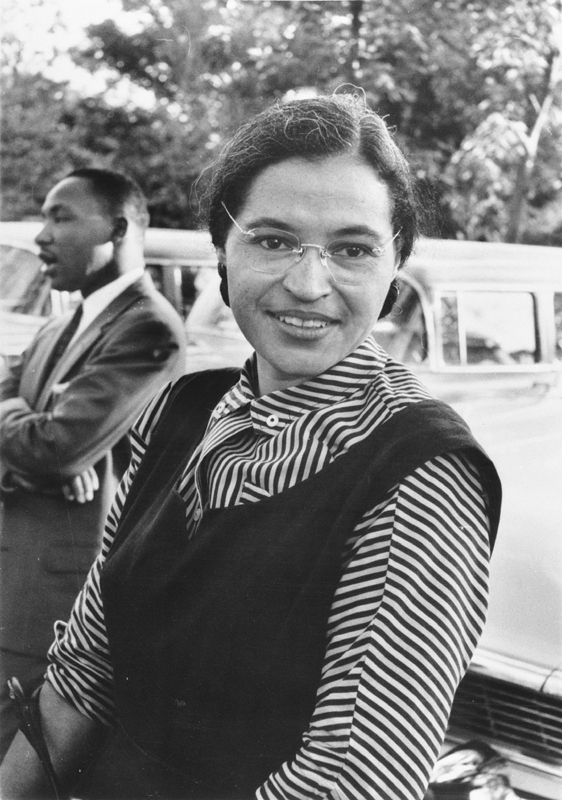Winner of the Fall 2016 StMU History Media Award for
Best Article in the Category of “People”
When one hears the name Rosa Parks, one is taken back in time to 1955, when a brave woman decided not to give up her seat. Rosa Parks was a woman who believed that the color of a person’s skin should not dictate the way a person is treated. Rosa Parks was a civil rights activist.

James McCauley, a skilled carpenter and stonemason, and Leona McCauley, a school teacher, were married on April 12, 1912, in Tuskegee, Alabama. Two months before their first anniversary, on February 4, 1913, in Tuskegee, Alabama they welcomed a daughter into their lives and named her Rosa Louise McCauley. On August 20, 1925 the McCauleys welcomed their son, Sylvester McCauley, into their family.1 The McCauley family decided to move to Abbeville, Alabama where they lived with James’s parents, sharing a bedroom with a large extended family. Rosa’s mother grew tired of the living arrangements and without her husband James around to support the family, she made the decision to leave. In 1917, when Rosa was only 4 years old, Leona took her two young children and moved back to Pine Level, Alabama where she and the children stayed with her parents. Rosa saw her father a year later when she was five and then again when she was an adult and married.2
Rosa received most of her education from her mother and grandfather as a little girl. In 1924, when Rosa was eleven years old, her mother enrolled her in the Montgomery Industrial School for Girls. The school was for African American girls seeking education; they were taught by mostly white teachers. The school focused on the domestic sciences of cooking, sewing, and housekeeping. The white people of the town accused the teachers of teaching racial equality and referred to them as Yankee black lovers. The school was later burned down by the Ku Klux Klan as they grew more powerful.3 After the Montgomery Industrial School for Girls closed in 1928, fifteen year old Rosa attended Booker T. Washington High School for her ninth grade year. She wanted to be a teacher just like her mother, so for her tenth grade year Rosa attended Alabama State Teachers College for Negros. Sadly, she had to drop out of school and return to Pine Level, Alabama to care for her grandmother who had grown ill. When her grandmother died in 1929, Rosa was only 16 years old. She moved back to Montgomery and found her first job making men’s blue denim work shirts at a textile factory. Soon after beginning her job in the factory, Rosa was forced to leave in order to care for her mother who had also grown ill.4 Rosa spent her teenage years cleaning houses and taking in sewing jobs. In 1931, Rosa met Raymond Parks, who worked as a barber and was a member of the National Association for the Advancement of Colored People (NAACP).5 The two fell in love and in December 1932, Rosa and Raymond were married. Raymond encouraged his new bride to go back to school so as to finish her education. This meant so much to her, and so Rosa completed her studies and received her high school diploma in 1934.6

By 1943 all buses in the South had long been segregated and had followed an extensive set of rules set forth by the bus drivers. Montgomery, Alabama was no exception to the segregation. All the buses had thirty-six seats; the first ten were reserved for whites only, ten seats in the back of the bus were for African Americans, and as for the sixteen seats in-between, these were for the bus drivers to decide. African Americans were frequently forced to give up their seats for whites and the bus drivers imposed their own segregation rules through the use of guns they carried with them.7
In November of 1943 Rosa boarded a bus in Montgomery, Alabama. African Americans were typically required to enter the bus from the doors located near the back of the bus, but since the bus was extremely crowded, Rosa was forced to enter from the front doors of the bus. The bus driver demanded she get off the bus and enter through the back door and Rosa refused, standing her ground and explaining to the bus driver that since she was already on the bus there was no need for her to get off because the back of the bus was already at capacity and she would not be able to enter from the back. The bus driver began tugging at Rosa’s coat to push her off the bus and so she decided to not create more of a scene and exited the bus.8
On December 1, 1955, Rosa headed to work at the Montgomery Fair Department Store on the Cleveland Avenue bus to Court Square. It was a normal day for Rosa, working her regular shift, busy as usual.9 Once work was over, Rosa was tired; her body ached, her feet hurt and were swollen from standing all day. Rosa walked to Court Square to wait for her bus and as soon as the first bus came, she saw that it was packed and decided to wait for the next one. Once the second bus arrived Rosa entered the bus, paid, and sat in the racially neutral middle section behind the movable sign which read “colored.”10 At the third stop, a group of whites entered the bus and since the last front seats were taken, one was left standing. The bus driver turned around and looked at Rosa. Rosa was shocked to see that it was the same bus driver she had had a problem with twelve years earlier. The driver, James F. Blake, began to shout at the passengers, “Move ya’ll, I want those two seats,” meaning he wanted Rosa to give up her seat. Rosa did not get up and Blake went straight to Rosa demanding she give her seat up. When Rosa still would not comply he warned her that he would have her arrested, to which she simply replied, “You may do that.”11
Once police arrived, Rosa was arrested, handcuffed and taken to the police station. At the station, Rosa was finger printed, photographed and placed in a cell. While in jail Rosa was treated badly. She requested a drink of water and a police officer yelled out to her “for whites only.” She even requested to make one phone call and was ignored. After requesting several times to make her phone call, she was finally given approval and she phoned her husband. Edgar Daniel Nixon, an African-American civil rights leader, paid a one-hundred dollar bond to bail Rosa out of jail. Rosa worked with Nixon as a branch secretary. In speaking with Nixon about the incident, Rosa decided to file suit and make a civil rights case regarding Montgomery’s bus segregation.12 On the day of trial, December 5, 1955, African Americans in Montgomery boycotted the buses and Rosa was found guilty of breaking segregation laws.13 The boycott proved to be a large protest, and it led to the formation of the Montgomery Improvement Association (MIA).14 On November 13, 1956, the Supreme Court ruled that bus segregation was unconstitutional and the boycott ended on December 20, 1956.15 Rosa became known as the mother of the Civil Rights Movement.16

Rosa Parks traveled and supported civil rights events and causes and even wrote an autobiography, “Rosa Parks: My Story.” In 1999, for all her accomplishments and beliefs as a strong African American, Rosa was awarded the Congressional Gold Medal, which is the highest honor in the United States presented to a civilian.17 On October 24, 2005, at the age of 92, Rosa Parks passed away. She became the first woman in the nation’s history to lie in state at the U.S. Capitol.18
Rosa Parks left a major impact on America and made history. She stood up for what was right for herself and for the people, not because of the color of their skin but because she believed that everyone should be treated equally. She boarded a bus at the end of a long work day, tired and wanting to go home, not realizing that she would forever change segregation in America. Rosa Parks was a very noble woman and she left behind a legacy that will never be forgotten.
- Salem Press Biographical Encyclopedia, January 2016, s.v. “Rosa Parks,” by Tammy K. Baggett. ↵
- Douglas Brinkley, Rosa Parks (Penguin Group Penguin Putnam Inc., 2000), 20-21. ↵
- Brinkley, Rosa Parks, 28, 29, 36. ↵
- Brinkley, Rosa Parks, 36. ↵
- Brinkley, Rosa Parks, 38. ↵
- Salem Press Biographical Encyclopedia, January 2016, s.v. “Rosa Parks,” by Tammy K. Baggett. ↵
- Brinkley, Rosa Parks, 57. ↵
- Brinkley, Rosa Parks, 58-59. ↵
- Salem Press Biographical Encyclopedia, January 2016, s.v. “Rosa Parks,” by Tammy K. Baggett. ↵
- Brinkley, Rosa Parks, 105. ↵
- Brinkley, Rosa Parks, 106-107. ↵
- Brinkley, Rosa Parks, 73, 108, 109, 111, 113, 114. ↵
- Brinkley, Rosa Parks, 152. ↵
- Brinkley, Rosa Parks, 134. ↵
- Brinkley, Rosa Parks, 152, 170. ↵
- Rosa Parks: “The First Lady of Civil Rights,” Bill of Rights Institute, March 2, 2012, http://billofrightsinstitute.org/rosaparks/. (accessed November 7, 2016). ↵
- Salem Press Biographical Encyclopedia, January 2016, s.v. “Rosa Parks,” by Tammy K. Baggett. ↵
- Salem Press Biographical Encyclopedia, January 2016, s.v. “Rosa Parks,” by Tammy K. Baggett. ↵




79 comments
Gabriela Serrato
I really enjoyed the amount of detail this article has. I thought it was very interesting to read Rosa Park’s background and early life story and I sympathized with the sacrifice she made to support her family. I feel blessed to have women such as her to look up to for many reasons. She was not afraid to make her voice heard in a time of oppression when in doing so it was very dangerous. She is truly brave for all of her actions and will forever be a role model to people from everywhere.
Sam Vandenbrink
This is a powerful article, everyone knows the story of Rosa Parks. The author does more then just tell the story of Rosa Parks, and how she wouldn’t move her seat on the bus, but goes into depth on how her life was set up to be the one to make a difference in history. She was raised by women and didn’t have a father figure in her life until it didn’t matter anymore. But her independence in life is really set up for this opportunity to change history!
Mariana Govea
Aww what an excellent article on Rosa Parks! What an outstanding lovely lady! Thanks to this article I learned so much about her background! I knew who she was and what she had done, but Ii never knew her whole story since her childhood and this article did a great job in ordering chronologically as events went by happening in her life! Her story is so inspiring to everyone in our nation! For her to have stood up for what she believed in that was not okay and to have the bravery to do it no matter what the consequences were, puts her above all of us and she deserves all the respect in the world that was not given to her by that ignorant bus driver! Great research on her early life! Much respect for all civil rights activists!!!
Alyssa Valdez
Amazing background information! Rosa parks has been a big part of history and I had no idea about her early life as a child and growing women. I think it is amazing that her husband supported and encouraged her to go back to school and finish her education. I also respect that she was willing to put a hold on schooling in the first place for her mother and grandmother. Amazing article!
Hayden Hollinger
I thought that this article was very interesting and detailed which provided me with the facts so I could understand the story of Rosa Parks more than the basic understanding I already had on her historic story. It is incredible to think that the bus driver who once caused her issues, 12 years prior, turned out to be the one that led to the moment that truly ignited the civil rights movement.
Erik Rodriguez
Amazing article! To think one womans actions changed the course of history. It is ashamed the simple act of not giving up her seat sent her to jail, but she set the standard. Rosa Parks played a fundamental role in the fight for equality.
Very well written! Great job!
Nicolas McKay
Rosa Parks was definitely a ray of hope in a very dark time for our nation. To think it was the same bus driver giving her trouble is truly uncanny. You did a wonderful job explaining and narrating an event that shaped human history.
Salvador Rodriguez Gomez
Loved the article! It is about an important woman who stood up for equal rights. I know the general story of Rosa Parks but I like how this article provides some background info and talks about some of her early childhood as well as provides a very detailed account of the events that transpired on that infamous bus ride.
Yesenia Cardenas
I had no idea that Rosa Parks attended a school mostly dedicated to learning home skills. To think that these institutions existed not too long ago shames me.
George Manzanares
To say the 60’s was not a controversial and crucial part of United States history would be a lie. Rosa Parks as well as other activists such as King played a crucial royal in shaping American society. Similiar to King, Parks played a huge role in the battle for civil rights. The boycott is one of the most famous acts of protests. Thanks to her and many others, civil rights activists gained a victory with the buses. Well done on illustrating her life!